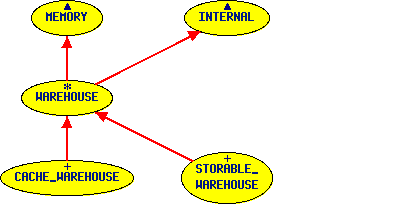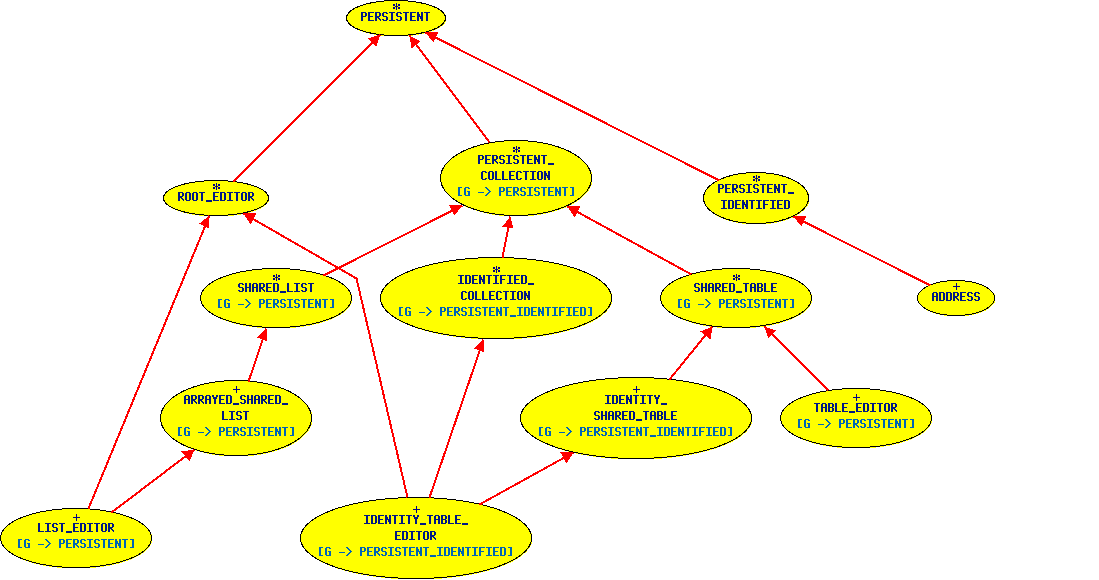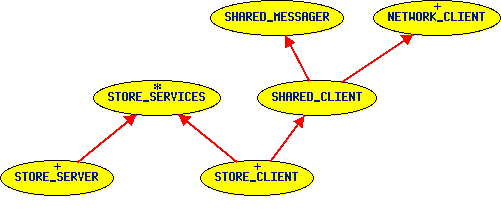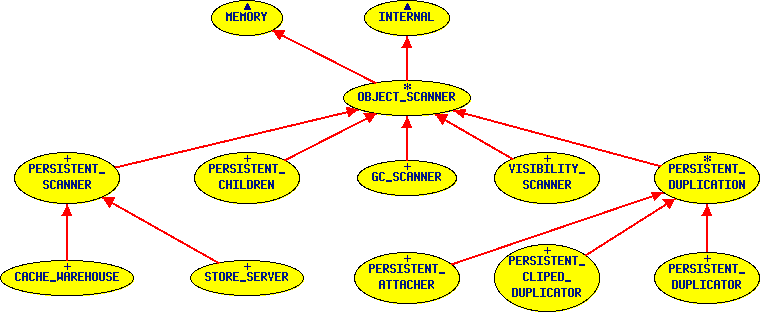 |
 |
 |
|
|
ShopIntroductionShop is an Eiffel library that allows sharing and storing persistent objects. Shop stands for Shared Objects that Persist. The main goal of this library is to provide the developer a set of persistent classes that help him develop business systems using ordinary classes and class structures together with persistent ones in an as much transparent way as possible. The main purpose of Shop is to allow to create multiuser application sharing a single object system.
Shop preserve the Eiffel programmer who want to preserve its Eiffel method and himself from technologies constraints. basically on wrote only one application with may run as server, client or event in standalone mode. One process play the role of object warehouse server. The other are clients. They communicate through TCP/IP sockets. The server first load the data from storage file and the start listening for client requests. Clients cache shared objects they needs. They only load data on demand. From the application program, except at the early beginning, it's no difference. One original and recommended approach, consist in writing only one application with switch to start either in single mode, server mode or in client mode. This ensure that the set of class is known in each cases. SharingIn the current context, we concept of sharing means sharing between separate processes. This not the usual concept of sharing object by references. Any sharable class must be a heir of the class PRESISTENT. This class has only one attribute: the pid (persistent identifier). This attribute is just an integer. All registered object, also called "alive" object have a positive pid. A newly created persistent object has a null (0) pid until it is registered in the warehouse. descendant from this class may include any type of attributes. Non sharable attributes are privates. In contrast all persistent attributes are normally sharable. The privacity of non sharable object is mandatory. If some non sharable attribute is already seen by an other persistent object, this attribute will be cloned accordingly to the persistence closure rule a the next duplication. Thus, the previous external reference any more to the body of that sharable object. The persistent cluster include also some classes to store structures. Basically this cluster contains persistent lists and tables. Those structure are compatible with usual lists an table but of course they have no cursors and the manipulation are subjects to some conditions. One could say that they are extendibles and prunable only if the client owns a valid reservation on that structure instance. Any reservation is only valid for one operation. Persistent closureThe persistent closure is the set of objects reachable from a persistent instance, but limited to the other persistent objects. In this set, all non persistent objects are private to the including persistent instance. The duplicata is the result of a duplication process of a persistent object. The duplicata and its persistent source, have disjoint sets of non-persistent attributes but do share the persistent attributes. The non-persistent attributes are deep clones limited to other persistent objects. A duplication is of course not alive (pid <= 0). The duplication mechanism is used to work properly on persistent object in a modification session, but also in the exchange mechanism between warehouses. Accessing attributes A basic persistent is said not safe. That applies either for ordinary objects or structures. That means that the access to a persistent attribute is direct like for any other Eiffel attributes. As a consequence when a client process requires an unsafe persistent object it will retrieve the persistent objects. To be safe, an object should only provides an indirect access to the persistent attributes. That indirect access allows to implement an on-demand access mechanism. If none of the persistent classes are safe the first access to a persistent root of a persistent system will poll the whole system. This is of course unacceptable for performance and even for sharing reasons. That is why, the instenciable lists and tables provided in the library have been made safe. Those classes are actually heirs of HASH_TABLE from the EiffelBase library made and maintained by Eiffel Software Inc (ESI-ISE). But it really easy to make the same type of adaptation for table from libraries. The instenciable lists looks like ARRAYED_LIST but should not be used as an "ACTIVE" structure. ClusterBasically there are only two clusters. The first include all persistent classes, the second include all the warehouse support classes. Warehouse A warehouse is a class that contains a persistent system. There are two type of warehouses: the storable one and the virtual one. The virtual warehouse is a local cache of a real storable warehouse. Warehouse caches only work in conjunction with a storable warehouse. The storable warehouse and the cache communicate through the network. The storage is an array of persistent object. This array has 1 as lower bound and is open on the other end. The pid of a persistent object actually is the index of this object into the storage array. The pid allocation process recycles all the unused slots. Therefore if the persistent system stay limited in number of persistent object, the maximum pid is kept stable after a certain running time.
warehouse also includes a persistent garbage collector (pgc). This garbage collector works incrementally at each insertion of a new instance. But, some mechanisms are provided to stop and restart the pgc. Normally, the storable warehouse completes the garbage collection cycle before storing data in file. The cache acts as a mirror of the storable warehouse but only includes the called pids. Normally, the root of the persistent system is always loaded into the cache at startup. The root pid is 1. It's normally a safe structure. That persistent root is thus loaded whit out the referred persistent items. These items are replaced by PERSISTENT_PROXY instances. PERSISTENT_PROXY is a simple class which only contains the pid value of the real object. These objects are the only called if needed. The cache drives the communication with the server of the storable warehouse. But the server may interleave events with the answers to the requests. However, the cache has a polling mechanism to retrieve pending events when it has nothing to ask to the server. The timing of that poll is adjustable. PersistentAny persistent class must be a heir of the class PERSISTENT. This class has only one attribute: the pid (persistent identifier). This attribute is just an integer. All registered object, also called "alive" object have a positive pid. A newly created persistent object has a null (0) pid until it is registered in the warehouse. descendant from this class may include any type of attributes. Non Persistent attributes are private. In contrast all persistent attributes are normally shareable. The private export status of non persistent object is mandatory. If some non persistent attribute is already seen by another persistent object, this attribute will be cloned according to the persistence closure rule (see hereafter). The persistent cluster also includes some classes to store collections. Basically this cluster contains persistent lists and tables. Those structures are compatible with usual lists an tables but they have no cursors and their manipulation is subject to some conditions. One could say that they are extendibles and prunable only if the client owns a valid reservation on that structure instance. Any reservation is valid for only one operation. Sharable object are also persistent. That means that the warehouse used by server is able to store data on file in order to restart the next session with these saved data. That the reason for the current naming of sharable object classes. Amount persistent descendant, the collections are of a particular interest.
NetworkingIn this context, the two main components are the STORE_SERVER and the STORE_CLIENT. Both are heirs of more general classes called SHARED_SERVER and SHARED_CLIENT. Most the concepts of sharing data between a server and some clients are in these ancestors. As depicted in the first figure, the STORE_SERVER performs the persistent clipping before
|








